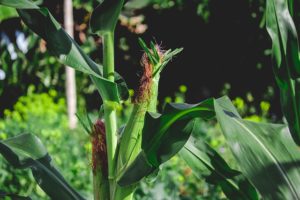Generalities
The economic and scientific importance of cereals motivates active research into their genetics, development and evolution. Maize Zea mays (known as “Corn” in American english) is an annual herbaceous tropical plant of the Poaceae family. It is widely cultivated as a cereal for its starchy grains, but also as a fodder plant. In science, maize is commonly used as a model organism in many disciplines, including developmental biology, genetics and epigenetics.
Given the economic stakes it represents at the global level and particularly in the United States, maize is a privileged field of application for genetically modified organisms (GMOs). Indeed, technical progress allows to develop transgenic varieties by incorporating into the genome genes encoding specific traits such as resistance to certain insect pests or herbicides. These genetically modified varieties are the subject of major debates at the global or European level, particularly in France.
Reproduction
Flowers are unisexual and arranged in male and female inflorescences. The female flowers are arranged in ears inserted in the axils of the median (largest) leaves. The axis of the ear (called a cob) bears 8 to 20 rows of female flowers. An ear may contain about 500 to 1,000 mature kernels (seeds). A plant can produce three or four ears, but only one usually achieves full development at the usual seeding densities. Male flowers are grouped in a terminal panicle that appears after the last leaf. This panicle consists of spikelets each containing two flowers with three stamens.
A maize seed is made up of three parts of different origins:
– the embryo, referred to as the “germ”, located at the seed’s basis. It comprises the proper embryo and the scutellum (i.e. the cotyledon), the storage organ from which the seedling draws its initial supply of energy. The embryo is derived from the egg formed from the fusion of the nucleus of a sperm cell and the oosphere,
– the albumen, a nutritive tissue, essentially composed of starch grains, except for the peripheral layer under the pericarp which contains protein-rich aleurone grains. This tissue results from the fusion of the nucleus of a sperm cell and the two nuclei of the central cell (thus a triploid tissue),
– the outer envelope, a thin, translucent, fibrous membrane from the pericarp of the ovary (thus part of the fruit and not the seed).
Tools
- Collections of populations, lines and natural mutants (approx. 10,000 lines) or produced by par EMS mutagenesis, or insertional mutagenesis (transposon insertion)
- Trangenesis
- EST libraries
- Transcriptomic analyses
Databases
Infrastructures
- URP3F - Unité de Recherche Pluridisciplinaire Prairies et Plantes Fourragères
- https://www6.nouvelle-aquitaine-poitiers.inrae.fr/urp3f
- Lusignan
- UMR Génétique Quantitative et Evolution - Le Moulon - équipe Génétique Quantitative et Méthodologie de la Sélection (GQMS)
- http://moulon.inrae.fr/equipes/gqms/
- Gif-sur-Yvette
- UMR Génétique Quantitative et Evolution - Le Moulon - équipe Génomique Evolutive et Adaptation des plantes Domestiquées (GEvAD)
- http://moulon.inrae.fr/equipes/gevad/
- Gif-sur-Yvette
Experts
- Alain CHARCOSSET
- charcos@moulon.inra.fr
- U.M.R. de Génétique Végétale du Moulon, équipe Génétique Quantitative et Méthodologie de la Sélection, Gif-sur-Yvette
Bibliography
- Articles
« The art and design of genetic screens: maize », Héctor Candela and Sarah Hake, nature review genetics, 2008
« Grains of knowledge: Genomics of model cereals » Andrew H. Paterson, Michael Freeling and Takuji Sasaki, Genome Research, 2005
« Of genes and genomes and the origin of maize », Shawn White and John Doebley, Trends in genetics,1998
- Websites
